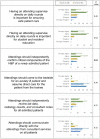This is a preprint.
Trainee Autonomy and Supervision in the Modern Clinical Learning Environment: A Mixed-Methods Study of Faculty and Trainee Perspectives
- PMID: 37333324
- PMCID: PMC10275050
- DOI: 10.21203/rs.3.rs-2982838/v1
Trainee Autonomy and Supervision in the Modern Clinical Learning Environment: A Mixed-Methods Study of Faculty and Trainee Perspectives
Abstract
Background: Balancing autonomy and supervision during medical residency is important for trainee development while ensuring patient safety. In the modern clinical learning environment, tension exists when this balance is skewed. This study aimed to understand the current and ideal states of autonomy and supervision, then describe the factors that contribute to imbalance from both trainee and attending perspectives.
Methods: A mixed-methods design included surveys and focus groups of trainees and attendings at three institutionally affiliated hospitals between May 2019-June 2020. Survey responses were compared using chi-square tests or Fisher's exact tests. Open-ended survey and focus group questions were analyzed using thematic analysis.
Results: Surveys were sent to 182 trainees and 208 attendings; 76 trainees (42%) and 101 attendings (49%) completed the survey. Fourteen trainees (8%) and 32 attendings (32%) participated in focus groups. Trainees perceived the current culture to be significantly more autonomous than attendings; both groups described an "ideal" culture as more autonomous than the current state. Focus group analysis revealed five core contributors to the balance of autonomy and supervision: attending-, trainee-, patient-, interpersonal-, and institutional-related factors. These factors were found to be dynamic and interactive with each other. Additionally, we identified a cultural shift in how the modern inpatient environment is impacted by increased hospitalist attending supervision and emphasis on patient safety and health system improvement initiatives.
Conclusions: Trainees and attendings agree that the clinical learning environment should favor resident autonomy and that the current environment does not achieve the ideal balance. There are several factors contributing to autonomy and supervision, including attending-, resident-, patient-, interpersonal-, and institutional-related. These factors are complex, multifaceted, and dynamic. Cultural shifts towards supervision by primarily hospitalist attendings and increased attending accountability for patient safety and systems improvement outcomes further impacts trainee autonomy.
Keywords: Trainee autonomy; clinical learning environment; supervision.
Conflict of interest statement
Competing interests: The authors declare that they have no competing interests.
Figures


References
-
- Accreditation Council for Graduate Medical Education (ACGME). Common Program Requirements (Residency). ACGME-approved focused revision: June 13, 2021; effective July 1, 2022. https://www.acgme.org/globalassets/pfassets/programrequirements/cprresid.... Accessed March 2, 2023.
-
- Bell BM. Reconsideration of the New York State laws rationalizing the supervision and the working conditions of residents. Einstein Journal of Biological Medicine 2003;20(1):36–40.
-
- Institute of Medicine (US) Committee on Quality of Health Care in America, Kohn LT, Corrigan JM, Donaldson MS, eds. To Err is Human: Building a Safer Health System. Washington (DC): National Academies Press (US); 2000. - PubMed
Publication types
Grants and funding
LinkOut - more resources
Full Text Sources

